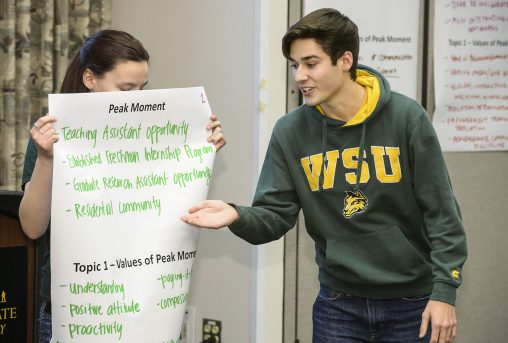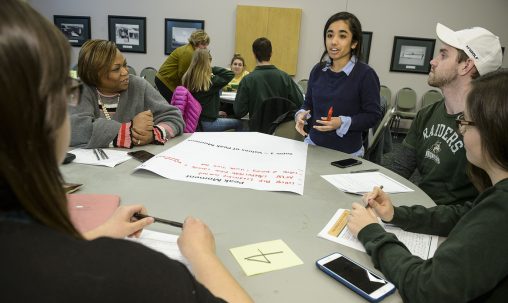
Participants gathered in small groups for intimate conversations in which they shared stories exemplifying peak moments of success they or others experienced at Wright State. (Photos by Chris Snyder)
A sense of belonging, more robust student life and an inclusive, welcoming campus were themes of Wright State University’s final strategic planning community dialogue session.
More than 40 students, faculty, staff and alumni came together to share stories about Wright State University during the dialogue session, which was hosted by the Student Government Association on March 13 in the Student Union Endeavour Room. The session was part of the strategic planning process, The Wright Path to 2025: Pride, Transformation, Potential.
Participants gathered in small groups for intimate conversations in which they shared stories exemplifying peak moments of success they or others experienced at Wright State.
Several students highlighted the leadership opportunities they have had at Wright State.
Alina Syed, a senior human resource management major, said those in her discussion group became better people thanks to opportunities that “allowed us to develop our potential as leaders.”
Ariel Ya’akov, a religion major, said the opportunities many students have had at Wright State “gave us purpose for why we are here” and inspired them to want to make a difference at the university.
Andrew Bautista, a psychology major, said joining a student organization helped him find his place at Wright State. “It helped me become part of something bigger than myself, and I fell in love with Wright State because it gave me a sense of belonging,” he said.
Several participants said they hoped the campus community could take steps to increase school pride and spirit.
Bautista said Wright State should endeavor to become the first choice for college for more students by enhancing student life and engagement on campus. The university should focus on student-centered initiatives so that more students “want to be here and are proud to be here,” he said.
Becca Webb, administrative specialist in the Department of English Language and Literatures, said each person in her discussion group shared stories centered on “building community with collaboration with effective leadership.”
More than 300 people participated in the nine community dialogue sessions over the last six weeks, providing data that the Strategic Planning Steering Committee will use to refine the university’s vision, mission and values statements.
The strategic planning process also includes the creation of a new plan aligned with university resources and metrics that can measure the outcomes of those strategies. The plan will guide decisions at the university on a day-to-day basis.
The planning process will continue after the strategic plan is complete, and it will regularly be revisited and adjusted based on the community’s continuous input.
The strategic planning process is intended to start an ongoing dialogue among the campus community that encourages continuous reflection and revision of the community’s hopes and priorities.
The strategic plan will guide Wright State by creating a vision and focus that directly aligns resources with the community’s values, strengths and the strategy built around them. The planning process will be continuous and will put Wright State in a position to thrive in higher education’s changing environment, help the university achieve financial sustainability and foster a campus atmosphere that provides graduates with opportunities to excel in fields that define the future.

The next step in the strategic planning process is a stakeholder summit on March 20–22 to refine the university’s vision, mission and values statements and identify goals for the strategic plan.
The Strategic Planning Steering Committee is guiding the university’s efforts to include a wide range of perspectives from the Wright State family and the broader community. The committee includes 33 Wright State employees, students and alumni as well as community leaders. It is co-chaired by President Cheryl B. Schrader; David Bright, chair of the Department of Management and International Business; and Michael Wiehe, director of the Applied Policy Research Institute.
The first phase of the planning process is focused on gathering community input to develop updated vision, mission and values statements for Wright State. The statements should reflect a compelling perspective about the core identity of Wright State and its future.
From March 20–22, more than 100 faculty, staff, alumni, students and community partners will participate in a stakeholder summit to refine the university’s vision, mission and values statements and identify goals for the strategic plan.
In April, the steering committee will host an event to unveil the updated vision, mission and values statements and a draft strategy statement.
From May through September, the committee will use what it learns from its outreach efforts in the spring semester to further develop strategy statements, priorities and goals, as well as metrics to measure the effectiveness of the strategies.
The goal is to deliver a strategic plan to the Board of Trustees by October 2018 for its approval.
You can stay up to date with the planning process by visiting wright.edu/strategicplan.


 Wright State supports deaf and hard of hearing community with Deaf Festival
Wright State supports deaf and hard of hearing community with Deaf Festival  Wright State students showcase scientific discoveries at annual research festival
Wright State students showcase scientific discoveries at annual research festival  Wright State medical students bring medicine to life for Mini University preschoolers
Wright State medical students bring medicine to life for Mini University preschoolers  Wright State Theatre to present rom-com musical ‘The Wedding Singer’
Wright State Theatre to present rom-com musical ‘The Wedding Singer’  Heavy metal learning
Heavy metal learning 